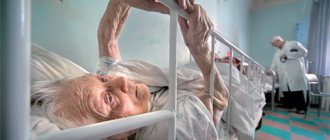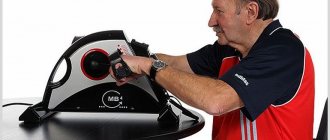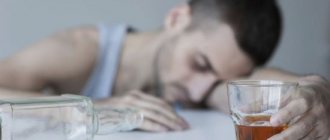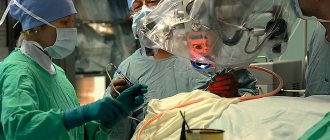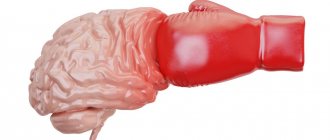Epilepsy after stroke forecasts
There are often cases when, after suffering an ischemic or hemorrhagic stroke, a person begins to have epileptic seizures.
They can appear for several reasons. Seizures are a consequence of acute vascular insufficiency. Statistics say that chronic epilepsy after a cerebral hemorrhage develops in 4-5%. This article will focus specifically on these attacks.
Causes
Epilepsy is a disease that occurs due to metabolic disorders in the brain. As a result, the nervous tissue becomes hyperexcitable: a strong discharge easily occurs in it, leading to an attack.
Reference! Scientists consider epilepsy to be a hereditary disease. The likelihood of getting sick increases if there are relatives in the family with a similar problem.
The following factors also increase the chance of developing seizures:
- head injuries;
- complications during childbirth;
- hormonal imbalance;
- frequent stress;
- non-compliance with the work and rest regime.
Often the disease is not independent.
It can serve as a symptom of other ailments.
These include meningitis, vascular pathologies, and poisoning with various substances.
It is customary to distinguish three main groups of attacks:
- Harbingers. They can occur months or even years immediately before the stroke itself. Their appearance is associated primarily with chronic vascular pathology.
- Early. Occurs in the first week after a stroke. According to statistics, such attacks account for 25% of all seizures.
- Late. They are fixed at least a week after an acute imbalance of normal blood flow. Sometimes the rate of post-stroke seizures reaches 70%. They can happen one or several times.
Frequency of development of epileptic seizures
After a stroke, the frequency of attacks varies depending on the person's age. In young children the figure does not exceed 2%. In school-age children it is fixed at 5%. When it comes to older people, the incidence of epilepsy reaches 20-30%.
In 2.5% of patients, seizures occur within the first six months after a stroke. Older men are more susceptible to the disease than others, since they have atherosclerosis, a tendency to smoke, and an increased concentration of fats in the blood.
How does the disease manifest itself?
All types of attacks are characterized by suddenness.
A few days before the attack, the patient may begin to complain of lack of sleep, headache, poor appetite, and constant fatigue.
Usually the attack goes like this:
- a man screams and falls sharply;
- he begins to have convulsions;
- Random urination is often observed;
- the patient’s breathing is disrupted, most of it becomes intermittent, and the pressure in the chest increases;
- if the case is classified as special, the tongue sinks in and liquid foam pours out of the mouth.
In this case, it is important to be able to provide first aid to the patient. If he still manages to fall, you need to put a cushion of clothing or a regular pillow under your head. You also need to make sure that the patient does not accidentally bite through his own tongue. At the same time, the clothes should not press on him: it is better to loosen the tie, and unbutton the collar button.
Sometimes an attack occurs while eating. Then it is recommended to remove food from the mouth by any means. In case of intermittent breathing or vomiting, it is better to turn the patient on his side. When convulsions are observed, the following steps should not be taken:
- perform artificial respiration;
- heart massage;
- hold limbs;
- open the patient's mouth;
- delay in calling doctors.
Unprofessional help can only harm the victim.
How dangerous is this?
If secondary epilepsy is detected, then some complications are possible, since the body is already weakened.
The first seven days after an ischemic stroke occur are considered the most difficult in medical practice.
Consequences of early epilepsy:
- loss of consciousness;
- a person may fall into a prolonged coma;
- breathing problems, as a person often accidentally swallows his tongue;
- pathologies of internal organs.
Important! Seizures after a stroke do not always indicate epilepsy. In this regard, diagnosis is necessary.
Treatment methods
Treatment of epileptic seizures in pensioners may seem much more difficult than at a young age. The thing is that the latter experience massive changes in the body, people’s cognitive abilities decline, and the risk of osteoporosis increases.
Source: https://golovnoj-mozg.ru/zabolevaniya/krovoobraschenie/epilepsiya-posle-insulta-prognozy
Epilepsy after stroke: prognosis and complications
When brain tissue is damaged, unpredictable consequences are possible: paralysis, seizures, coma.
If epilepsy occurs after a stroke, the prognosis will depend on the speed of response of medical personnel and the subsequent condition of the patient in the first days.
The chronic form of the disease develops in people only in 4-5% of cases. But there are acute situations when epilepsy lasts for several days or weeks.
Types of seizures after a stroke
Doctors distinguish 3 forms of post-stroke epilepsy:
- Harbingers . Usually begin several months or years before the onset of a stroke. They are mainly associated with the ischemic form of the disease, which is characterized by oxygen starvation and impaired blood circulation in certain areas of the brain for a long time. In some patients, a mini-stroke is predicted several days or weeks in advance.
- Early attacks . They develop within 6-7 days after the onset of an ischemic attack. Seizures are acute in nature and can appear either together with a stroke or immediately after it. If help is provided in time, the prognosis is favorable.
- Late attacks . They develop 7-8 days after a stroke. Occurs in 65-70% of patients, so you need to be prepared for a similar condition within the specified time after acute ischemia. The prognosis worsens if first aid is provided too late.
Epilepsy can be called only those seizures after a stroke that persist for some time.
Causes of post-stroke seizures
The prognosis, complexity of treatment and the patient’s condition depend on what causes epilepsy after a stroke. There are several groups of reasons. The first is general, not directly related to ischemia: long-term withdrawal of alcohol in those suffering from alcoholism, sudden changes in sugar levels, withdrawal of anticonvulsants, changes in sodium in the blood.
Post-stroke epilepsy appears as a result of the use of drugs to treat ischemia: muscle relaxants, antibiotics, antidepressants, antiarrhythmic drugs, phenothiazines.
The causes are also neuralgic disorders that affect the prognosis in the long term: initial changes in the brain, arteriovenous malformation, thrombosis, cytopathy or hypertensive encephalopathy.
When medical errors worsen the prognosis, an incorrect diagnosis is often found: a brain tumor or abscess, encephalitis that developed against the background of herpes simplex, or subdural empyema.
Factors that provoke attacks
In recent years, the number of patients who develop epilepsy after a stroke has increased significantly. WHO names old age as the main factor provoking its development. Due to changes in regeneration functions and general aging, the body can no longer cope normally with injuries received, including changes in the structure of the brain.
In the post-stroke state, epilepsy occurs in 3 stages:
- onset - due to disturbances in the damaged area, general blood circulation in the brain worsens;
- due to chronic oxygen starvation, coronary disease appears, causing mild convulsions;
- after an acute attack of ischemia, an epileptic seizure develops immediately or after a short period of time, depending on changed metabolic processes.
However, post-stroke epilepsy does not always develop solely against the background of ischemic damage. With hemorrhagic hemorrhage, which involves more than 1 lobe of the brain, a convulsive state is also possible.
Course of attacks after circulatory disorders
The first signs of epilepsy develop within a few days after suffering a stroke. In some cases they occur after the first week. Seizures occur unexpectedly and cannot be recognized in advance.
In approximately 90% of cases, the condition occurs against the background of damage to cortical structures and due to the formation of cystic formations. Due to scarring of damaged tissue, some patients experience late attacks that occur several months after the stroke.
According to the sensations, patients note the following conditions when an epileptic attack approaches after a stroke:
- the psycho-emotional state changes: insomnia develops, appetite disappears, severe weakness occurs, from which you don’t want to get out of bed, and headaches often occur;
- the aura period is a state in which a person feels something incomprehensible, his perception changes. The aura is different for each person, and it is impossible to name common symptoms;
- loss of consciousness - not all attacks can be recognized before a seizure; before loss of consciousness, convulsions always begin, pressure in the chest increases, breathing changes, in severe cases, the tongue sinks and foam appears at the mouth.
Single epileptic seizures after a stroke do not fully indicate the development of the disease. Immediately after restoration of metabolism, most patients’ condition returns to normal and they no longer experience attacks. If epilepsy recurs, this indicates a chronic form.
Danger of seizures
A stroke dramatically weakens one’s health, and post-stroke epilepsy only undermines one’s overall well-being. If in a person who does not suffer from other pathologies, the disease does not lead to extremely severe consequences, then in a person who has suffered a hemorrhage, the risk is high: the person falls into a coma, dysfunction of various organs occurs, blood circulation worsens, and vascular health worsens.
The process of post-stroke epilepsy itself is also dangerous, during which the patient can suffer head injuries. Some experience respiratory arrest, against which secondary hypoxia develops.
In severe cases, epilepsy can cause disability - constant seizures lead to irreversible changes in the brain.
Due to post-stroke epilepsy, a person has an increased risk of having a recurrent stroke.
If it happens, the chances of survival are reduced several times. With frequent convulsions that do not go away after attempts at treatment, doctors assume the presence of internal bleeding, which ultimately causes death.
Timely assistance increases the chance of recovery and affects the favorable prognosis. But, if medical participation does not occur, then with a 90% probability the person dies or becomes disabled.
First aid for seizures
If the attack began far from a medical facility, relatives and friends can help a patient with epilepsy:
- you must immediately call an ambulance;
- if a person faints, he must be laid down at the place of the fall and freed from tight clothing;
- fresh air is needed - open the windows;
- the head is raised higher than the legs, it is necessary to ensure that there are no open injuries that occur as a result of a fall;
- then you need to check if there is any food left in your mouth; if any food is found, you need to take it out;
- if a person has removable dentures installed, the ears are removed from the oral cavity;
- if convulsions with wheezing occur, the body should be turned on its side and ensure that breathing does not stop;
- if the seizure lasts longer than a few minutes, you need to gently hold the patient so that he does not hit himself or receive other injuries, but it is impossible to prevent seizures by holding his arms and legs;
- If a person is conscious, but severe muscle spasms occur, they can be rubbed using the recommended products (for example, olive oil).
After the ambulance team arrives, you need to describe the patient’s well-being and say what medications he took. The more accurate the descriptions are, the greater the chances of a favorable treatment prognosis.
Causes
Epilepsy after a stroke occurs when the cerebral cortex is in an agitated state. This can happen for a number of reasons; seizures do not always occur as a concomitant phenomenon. Sometimes a cerebrovascular accident is the starting point, after which other circumstances come into play.
Doctors divide post-stroke seizures into 3 large groups:
- Not directly related to stroke. For example, a prolonged absence of alcohol in the alcoholic's body, a break in taking anticonvulsants, a sharp change in sodium or blood sugar levels. That is, the combination of a stroke and seizures after it is just a coincidence.
- Directly caused by ischemia. They occur as a result of taking medications of various types, damage to the brain, or the circulatory system. The prognosis is determined by the massiveness of neuronal damage due to circulatory disorders.
- Medical errors of various types. An incorrect diagnosis of stroke or epilepsy worsens the situation, provoking the development of a pathological condition.
All about epileptic seizures during stroke
The high incidence of stroke entails a high prevalence of post-stroke epileptic seizures, which can occur in people with or without epilepsy.
Epileptic seizures provoked by acute vascular insufficiency can be a consequence of systemic disorders in the body or direct damage to the brain. 4–5% of people develop chronic epilepsy after a stroke.
Vascular insufficiency may cause seizures after stroke
There are 3 groups of seizures:
- Precursor seizures occur months or even years before a stroke. Their appearance is associated with chronic vascular insufficiency and may be the only symptom of a transient ischemic attack (ministroke), a “silent” stroke.
- Early, occurring in the first week of the disease. They account for up to 25% of all post-ischemic attacks. Among the early ones, it is necessary to distinguish the most acute seizures that occur simultaneously with the onset of a stroke or immediately after it. Some doctors include all seizures that occurred before the disappearance of acute signs of cerebral ischemia as early attacks.
- Late, starting 7 days or later after an acute cerebral circulatory disorder. They account for 65–70% of post-stroke seizures. Seizures can be single or recurrent, and only late recurrent seizures should be called post-stroke epilepsy.
How often does the disease occur?
The risk of developing seizures after a stroke varies greatly depending on the person's age: it develops in 2% of children under 2 years of age and in 5% of children 8 years of age, with a second peak occurring between the ages of 17 and 23 years, but the highest incidence is observed among patients older than 60 years – 20–30%.
In 2.5% of patients they develop during the first year after a stroke and in 5% in the next 5 years. Elderly men are more susceptible to the disease, since they have more risk factors - smoking, atherosclerosis, high blood fat levels.
Post-stroke epilepsy develops in 3–5% of people after a moderate stroke and in 20% after a severe form.
With hemorrhagic stroke, the disease develops 2 times more often than with ischemic stroke.
Causes
The reasons are not fully understood, but it can be confidently stated that various disorders of the blood supply to the brain play a leading role in the development of the disease - atherosclerosis, blood clots, abnormalities in the development of cerebral vessels, ischemia. An important role is played by brain damage when blood sugar levels change as a result of side effects of medications.
Development mechanism
Biochemically, the development of epilepsy is associated with disruption of ionic and energy processes and nerve impulse transmission. These disorders lead to extremely high excitability of nerve cells, and then to seizures.
Epileptic seizures are caused by disturbances in the transmission of nerve impulses
Early attacks are caused by metabolic disorders in the area of ischemia, as well as the negative impact of ischemia on healthy brain structures - a sudden impulse and high discharges of nerve cells appear.
Early attacks stop immediately after the restoration of metabolic processes in the lesion.
The development of late attacks is associated with the formation of cysts after a stroke and the replacement of nervous tissue in the cortex or white matter of the brain.
The location of the infarction plays a leading role in the occurrence of an attack - attacks occur when the cerebral cortex is damaged and practically do not occur when the subcortex, cerebellum, thalamic region, or deep layers of the brain are damaged.
Treatment
Treatment of post-stroke seizures is much more difficult than treatment of epilepsy in young people.
This is due to the age of the patients - the condition of older people is aggravated by age-related changes in the body (liver and kidney failure), and mental impairment.
Older people take a sufficient amount of medications to treat comorbidities, which subsequently poses the risk of drug interactions. In people over 50 years of age, taking antiepileptic drugs increases the risk of developing osteoporosis.
Treatment principles:
- It is necessary to avoid prescribing medications that provoke seizures. A classic example is Eufillin, but theoretically most vascular and metabolic drugs can provoke an attack, but practice shows that their administration does not play a big role in the treatment of acute cerebral circulatory disorders and does not affect its consequences. But Magnesium sulfate and Diacarb are not able to provoke epilepsy and even have a slight antiepileptic effect.
- It is necessary to treat stroke and somatic diseases, since the occurrence of epileptic seizures is associated with cerebral edema, displacement of brain structures, increased and decreased blood sugar, decreased potassium levels and intoxication as a result of renal failure.
- It is necessary to carry out anticonvulsant treatment. If the patient is conscious, he is prescribed tablets; if, due to the severity of the condition, the swallowing reflex is impaired, injections have to be given or medications administered through a tube, Depakin, Konvulex, Levetiracetam, Propofol are used. The listed drugs relieve the symptoms of an attack, but do not treat epilepsy or reduce the risk of its occurrence.
Comprehensive drug treatment will help relieve the patient from epileptic seizures
The listed drugs are prescribed strictly justifiably, since they have a number of side effects that aggravate the severity of cerebral ischemia. They need to be prescribed:
- patients with active seizures;
- patients in a coma whose electroencephalogram shows signs of epilepsy (increased convulsive activity);
- stroke patients who had early attacks;
- Patients with a severe, extensive form of stroke require prophylactic administration of antiepileptic drugs in a situation where the possible occurrence of an attack threatens deterioration of health or death.
The threat to a sick person is not muscle cramps, but the resulting huge electrical discharges in the cerebral cortex. Therefore, treatment should continue not until the seizures are eliminated, but until normal electroencephalogram readings are restored.
Seizures caused by a stroke are relatively treatable.
Post-stroke epileptic seizures significantly worsen the clinical picture of stroke; negative consequences include a decrease in the quality of life of patients in the acute and recovery periods of the disease. And the most undesirable consequence is that epilepsy provokes new attacks of acute cerebrovascular accident.
Source: https://GolovaLab.ru/insulto/simptomy/epilepticheskiy-pripadok-pri-insulte.html
How to get rid of post-stroke epilepsy seizures
Treating epileptic seizures is quite difficult, even in patients who have not had a stroke.
A neurologist is required to understand the mechanisms of disease development. Before prescribing a course of therapy, a thorough examination of the patient, neurological diagnostics, and an assessment of the body’s condition are carried out. When treating symptomatic epilepsy with pharmacological agents, it is necessary to take into account the interaction of the prescribed drugs with those that the victim is already taking.
Traditional therapy involves prescribing the following drugs:
- Carbamazepine.
- Valproic acid preparations.
- Convulsofin.
- Depakine.
Prescription of Depakine is especially effective in the treatment of elderly people. The drug does not cause cognitive impairment and does not depress respiratory function. Epilepsy attacks can be stopped with the help of new generation drugs - Lamotrigine, Tiagabine, etc.
Epilepsy after stroke: prognosis for recovery after epileptic seizures
There are often cases when, after suffering an ischemic or hemorrhagic stroke, a person begins to have epileptic seizures. They can appear for several reasons.
Seizures are a consequence of acute vascular insufficiency. Statistics say that chronic epilepsy after a cerebral hemorrhage develops in 4-5%. This article will focus specifically on these attacks.
Prognosis for recovery
Changing your diet will help reduce the frequency of attacks.
To do this, you must adhere to the following rules:
- stop eating meat , that is, adhere to the concept of vegetarianism;
- priority should be given to dairy and plant products;
- the patient needs to stop smoking ;
- You should try to add less salt or avoid it altogether;
- Spinach should be included in your diet .
Wormwood, from which it is suggested to prepare a decoction, will help to get rid of and prevent epilepsy attacks. To do this, take three tablespoons of the plant in dry form and a liter of boiled water. The whole mixture is simmered over low heat, then covered with a lid and infused. Twice before meals you need to drink half a standard-sized glass of the decoction.
Surgery will help stop the attacks completely, but this method is an extreme option. A generator is inserted under the patient's skin, which stimulates the vagus nerve through impulses.
Important! The operation is not always possible, since the effect of it may be worse than the epileptic seizures themselves.
Statistical information shows that 70% of patients can be cured of epilepsy with properly selected complex treatment. If attacks do not bother a person for three years, he is considered to have fully recovered.
on this topic:
conclusions
Thus, epilepsy after a stroke is not a death sentence. Modern medicine has learned to deal with these types of attacks, so their frequency and intensity are reduced with the right approach. It is important to recognize a seizure in time and provide first aid correctly to avoid death.
Source: https://doktor-ok.com/zabolevaniya/golovnogo-mozga/insult/epilepsiya.html
How to live with post-stroke epilepsy
Epilepsy after a stroke can occur for various reasons, but the main factor in its development remains the patient’s advanced age.
Provided proper rehabilitation measures are carried out, the functions of the brain tissue are gradually restored. The frequency of epileptic seizures decreases, and under favorable circumstances, seizures can stop completely. Regular use of antiepileptic drugs significantly improves the patient's quality of life.
The victim and his family will have to learn to distinguish between the conditions that precede the development of an attack, and also to determine for what reasons epilepsy attacks occur after a stroke. Regular consultation with a neurologist and adjustments to eating habits and lifestyle will be required.
It is also recommended to stop drinking alcohol and smoking. A healthy lifestyle and regular medications will help you adapt to the new condition and lead a relatively normal life.
Epilepsy after stroke causes, symptoms, treatment and prevention methods
Post-stroke epilepsy is a neurological pathology that occurs against the background of an ischemic or hemorrhagic stroke and is accompanied by convulsive seizures.
Occurs in every tenth patient after an attack of acute circulatory disorders in the brain. It can be idiopathic (arising for unknown reasons) and secondary (arising as a result of neurological disorders in the body).
To cure seizures, you need to see a neurologist.
What does epilepsy after a stroke mean?
The occurrence of epileptic seizures indicates instability of the nervous system and the presence of neurological abnormalities. Characteristic symptoms of the pathology:
- slight dizziness, feeling of discomfort;
- visual and auditory hallucinations;
- partial loss of consciousness;
- memory losses;
- nervous disorders;
- seizures with loss of consciousness;
- uncontrolled movements;
- muscle weakness of the body;
- spasms and convulsions.
What diseases can epilepsy during a stroke be confused with?
Epileptic seizures are often confused with bipolar disorder due to similar symptoms:
- frequent mood swings, sudden change from joy to aggression;
- symptoms of depression (dejection, indifference, fatigue, decreased concentration);
- it is almost impossible to establish the main and single cause of the disease;
- manifests itself in children, adolescents, adults and the elderly equally.
How to relieve symptoms?
If a patient begins to have a seizure, several actions need to be taken:
- Lay the person horizontally, unbutton their clothes so that they can breathe freely.
- If severe cramps occur, roll the person onto their side.
- There is no need to tie up the patient, perform cardiac massage or perform artificial respiration!
- Keep the patient's head elevated.
- Do not put any objects into your mouth to avoid damaging your jaw.
To cure the disease, you must first undergo diagnostics in a specialized clinic. Doctors prescribe the following studies:
- neuropsychological studies;
- Doppler ultrasound of the brachiocephalic arteries;
- CT and MRI of blood vessels and soft tissues of the brain;
- electroencephalography;
- electrocardiography;
- general blood and urine tests;
- blood biochemistry;
- cerebrospinal fluid puncture.
Drug treatment
During drug therapy, most doctors prescribe antiepileptic drugs of various groups. Medicines are aimed at inhibiting seizures, calming nerve fibers, preventing the transmission of electrical impulses, and restoring cerebral circulation. What drugs are most often prescribed:
- carbamazepine;
- lamotrigine;
- phenobarbital;
- ethosuximide;
- diphenin;
- levetiracetam;
- topiramate;
- hexamidine;
- anticholinergics;
- valproic acid.
The drugs can be prescribed in the form of tablets, capsules or injections.
Surgery
Surgery is used only in severe cases; surgical removal of the epileptogenic area of the brain is usually used. The procedure is performed endoscopically under a microscope. Such operations as lobectomy, hemispherectomy, hippocampectomy, and callosotomy are in demand abroad.
Conservative therapy
Physiotherapeutic procedures are used to treat epilepsy and quickly recover after a stroke:
- oxygen therapy;
- ozone therapy;
- pine baths;
- electrophoresis;
- UV irradiation.
Therapeutic exercises, relaxing massage, swimming, as well as diet and daily routine are considered effective.
Sources
- “The effectiveness of treatment of focal epilepsy in patients who have suffered a stroke”, YuA Belova, IG Rudakova, AS Kotov, Sergey Vladimirovich Kotov. Clinical gerontology 20 (7-8), 6-8, 2014.
- “Some risk factors for the development of post-stroke epilepsy,” EK Muromtseva. Postgraduate Bulletin of the Volga Region, 48-52, 2013.
- “Post-stroke epilepsy: predictors, risk factors, clinical options, treatment”, Tatyana Valerievna Danilova, DR Khasanova, IR Kamalov. Neurology, neuropsychiatry, psychosomatics, 2012.
Diagnostic accuracy and quality service are the main priorities of our work.
We value every review our patients leave us.
Panina Valentina Viktorovna
Actress, Honored Artist of the RSFSR
I found out about you on the Internet - I urgently need an MRI.
And after the performance I’m with you. I really liked your staff. Thank you for your attention, kindness and accuracy.
May everything be as good in your soul as I am now, despite all the problems...
Be!!! We're happy! Your Panina V.V.
Open review scan
Array( [ID] => 107 [~ID] => 107 [CODE] => [~CODE] => [XML_ID] => 107 [~XML_ID] => 107 [NAME] => Panina Valentina Viktorovna [~NAME ] => Panina Valentina Viktorovna [TAGS] => [~TAGS] => [SORT] => 100 [~SORT] => 100 [PREVIEW_TEXT] =>
I found out about you on the Internet - I urgently need an MRI.
And after the performance I’m with you. I really liked your staff. Thank you for your attention, kindness and accuracy.
May everything be as good in your soul as I am now, despite all the problems...
Be!!! We're happy! Your Panina V.V.
[~PREVIEW_TEXT] =>
I found out about you on the Internet - I urgently need an MRI.
And after the performance I’m with you. I really liked your staff. Thank you for your attention, kindness and accuracy.
May everything be as good in your soul as I am now, despite all the problems...
Be!!! We're happy! Your Panina V.V.
Source: https://cmrt.ru/zabolevaniya/golovnogo-mozga/epilepsiya-posle-insulta/
Treatment
The main goal of treating epilepsy after a stroke is to prevent the development of recurrent seizures. In order to avoid the progression of the disease and its severe consequences, an anticonvulsant drug is selected for a particular patient, based on the body’s susceptibility and combination with other medications taken.
The regimen also uses antithrombotic agents and drugs that improve blood circulation.
In addition, to improve the patient's condition, certain rules must be followed:
source
Epilepsy after a stroke - what is its danger and how to treat it?
18.09.2017
People who have had a stroke are at risk of having epileptic seizures, since during a stroke some brain cells die, and the larger the affected area, the higher the risks.
Epilepsy after a stroke is diagnosed in about 10% of patients, mostly elderly people.
What triggers an epileptic seizure after a stroke?
In recent years, there has been an increase in the number of people who develop epilepsy after or before a stroke. The central cause of epileptic seizures is considered to be the age of the patient: the brain of an elderly person cannot fully recover after suffering a disruption in blood circulation.
Epilepsy develops gradually, and this process can be divided into stages:
- Various vascular diseases (atherosclerosis, thrombosis), damage, and blood loss contribute to the weakening of blood flow, and it cannot fully supply brain cells with oxygen and deliver other useful substances.
- Due to disruptions in blood circulation, cerebral ischemia occurs: the functioning of the nervous system is disrupted, problems with memory and sleep develop, later severe headaches, visual and hearing impairments, dizziness, motor disturbances appear, and a person may periodically lose consciousness. Attacks may also appear, usually weak in intensity, manifested in the form of impaired reflexes in the tendons, which are precursors of an ischemic stroke.
- Stroke of an ischemic nature and epileptic seizures have a relationship: usually the first signs of post-stroke epilepsy appear a week after an ischemic stroke.
The strength of epileptic post-stroke seizures can be used to judge how damaged the brain cells are.
How do epilepsy attacks occur?
An epileptic seizure occurs suddenly and is usually associated with atrophy of the cerebral cortex, metabolic failures in the damaged area, or the formation of cysts in the place of cells killed due to a stroke, which compress neighboring areas of the brain.
There are also so-called late attacks, which can appear several weeks or months after a disruption in cerebral circulation and occur due to scarring of damaged brain tissue.
Stages of development of an epileptic attack:
- The attack is preceded by a variety of mental and emotional disturbances: high levels of irritability, anxiety, loss of appetite, sleep disturbances, rapid heartbeat.
- Then an aura appears - a special state that occurs shortly before a seizure. It manifests itself differently in each patient and may include the following symptoms: hallucinations (visual, auditory, olfactory and others), a pronounced feeling of fear, painful sensations in any parts of the body, a feeling of coldness in the extremities, a feeling of deja vu and many others.
- The attack begins with a spasm (tonic convulsions): the patient’s muscular system goes into a state of tension, the body arches and maintains this position, the head is thrown back. After this, clonic convulsions begin, during which the muscles actively contract and the secretion of saliva increases, which looks like foam. The person's breathing is hoarse and convulsive.
One or more seizures that occur after a stroke do not always indicate that the patient has developed epilepsy: over time, in many patients, the seizures stop when metabolic processes in the brain are restored.
Danger of epileptic seizures
Epilepsy attacks greatly complicate the patient’s recovery process; they are especially dangerous in the first day after a stroke, as they greatly overstrain an already weak body.
There are the following dangers of epilepsy after a stroke:
- Impaired consciousness that occurs during a seizure can develop into a coma, which is extremely dangerous for a person who has recently suffered a stroke.
- During an attack, a person is not able to control himself and, if he falls, he may receive injuries, sometimes serious, which can aggravate the course of epilepsy (especially if these are head injuries) and complicate the recovery process after a stroke.
- During a seizure, the tongue sinks, and this can lead to problems with breathing. It is important to turn the person's head to the side during a seizure; this will also help saliva flow rather than accumulate in the mouth.
How to live with post-stroke epilepsy?
Usually, after high-quality rehabilitation of the patient, there are fewer seizures, sometimes they disappear completely, as the brain is restored and blood flow improves.
But the patient will have to take medications that stop attacks for a long time, often throughout his life, and can only be canceled by the attending physician, who will conduct all the necessary studies before doing so.
A person with epilepsy is advised to adjust their diet, give up bad habits and avoid things that can trigger an attack: flashing lights, rapid frame changes, etc.
Compliance with all recommendations will help the patient live an almost full life and not experience significant discomfort due to his condition.
How to live with post-stroke epilepsy?
The frequency of epilepsy attacks decreases, and in the best case, seizures stop altogether.
For the best result, the patient will need to regularly visit a neurologist, adjust his lifestyle: establish correct eating habits, stop smoking and drinking alcohol, and forget about hard physical work.
Regular taking of prescribed medications and basic care of your own health will help improve the patient’s condition and actually return him to normal life.
